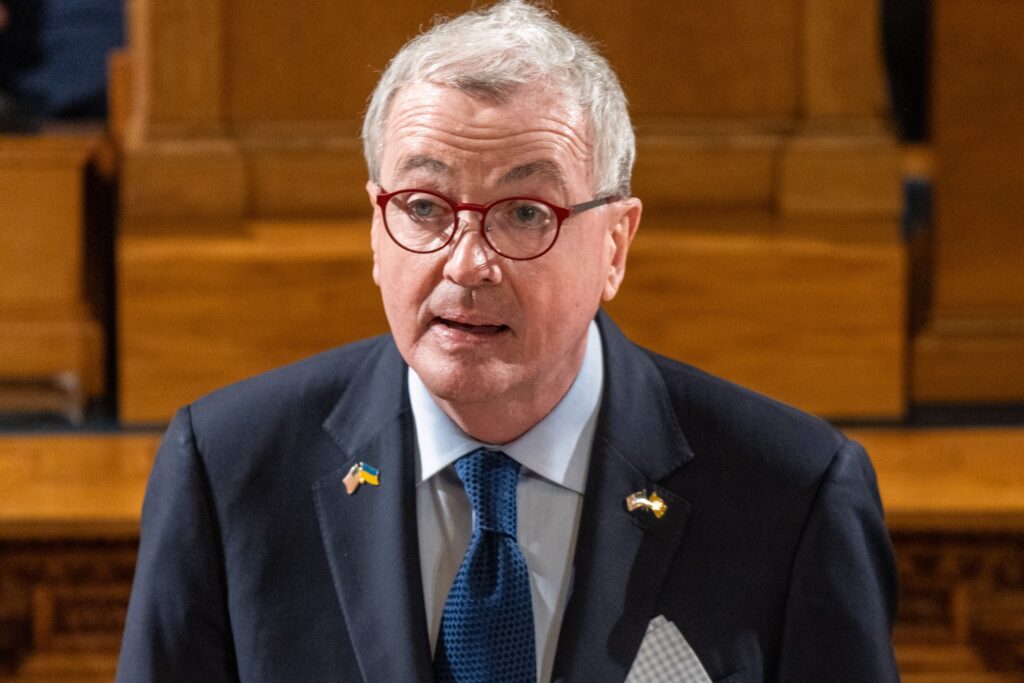
Gov. Phil Murphy called the measure necessary but said broader issues regarding health insurance coverage for local government employees remain a concern. (Hal Brown for New Jersey Monitor)
Gov. Phil Murphy signed legislation that will allow the State Health Benefits Program to issue loans from a fund covering state workers to one covering local government employees, with the latter facing a financial spiral spurred by municipalities’ flight to other health benefit plans amid high premium increases.
The bill, which was signed into law Wednesday, less than a week after its introduction, allows the state’s pension and benefits division to initiate no-interest loans from the state fund to the local government fund if the latter’s reserves fall too low to cover 10 days of expenses.
“While today’s legislation is a necessary measure, broader issues regarding health insurance coverage for local government employees are of concern to my Administration and a large number of constituencies,” Gov. Phil Murphy said in a statement.
The loans could cover up to 30 days of the health benefit costs for local governments and must be repaid within 120 days of being issued, though the division can extend that deadline to 365 days.
The bill’s signing comes about a month after state officials approved the latest round of double-digit premium increases for the state benefit plans.
In September, the State Health Benefits Commission approved a 10.1% rate hike for state workers’ health premiums and a 16.3% increase for their local government counterparts.
Contractual provisions limited the increase in state workers’ contributions to 4.5%, but municipal and county employees will face the full brunt of their larger hike, which came on the heels of a 7.4% increase last year and a more than 20% increase the previous year.
“Republicans have been warning of the looming death spiral facing our public health benefit systems,” Sen. Declan O’Scanlon (R-Monmouth) said on the Senate floor Monday. “As evidenced by the urgent need, apparently, of this legislation, it’s no longer looming. It’s hitting us here and now and should horrify and scare every public worker and every taxpayer in New Jersey.”
The steep consecutive hikes have spurred some local governments to move to private health care plans. Active employee enrollments in the local government plan part fell by roughly 18% in the two years after officials approved double-digit increases in 2022.
Health insurance plans function by diluting risk. Broadly, premiums paid by healthier workers who are less likely to fall sick help fund medical care for others, but as enrollments fall, risk and premiums rise.
That dynamic has fueled worries of a cycle that could see rates balloon as more and more local units move to private options in the face of rising premiums, eventually sending the state plan into a spiral of escalating costs.
“We’ve been screaming in the wind about this for years now in capital letters, underlined, in bold, and italicized,” said Mike Cerra, executive director of the New Jersey League of Municipalities. “It heightened a couple of years ago when it was the over 20% increase, and now 16% — this isn’t sustainable.”
Departures by municipalities with large workforces — like Newark, which moved its roughly 8,000 employees to a private plan last year — are particularly damaging.
Leaving the state-run plan isn’t feasible for every local government, Cerra said, and those with few employees, older workforces, or especially sick workers could have little choice but to face escalating costs head-on.
“The employers that can’t leave are getting like a double and triple whammy at this point,” Cerra said.
He called the bill a “necessary Band-Aid” but said changes proposed by labor members on committees charged with the design of public worker health benefit plans — like one that would tie certain prices on the public plans to Medicare rates — were needed to curtail costs.
Treasury officials are set to meet with local leaders to discuss health benefit costs in the coming days.
GET THE MORNING HEADLINES.

